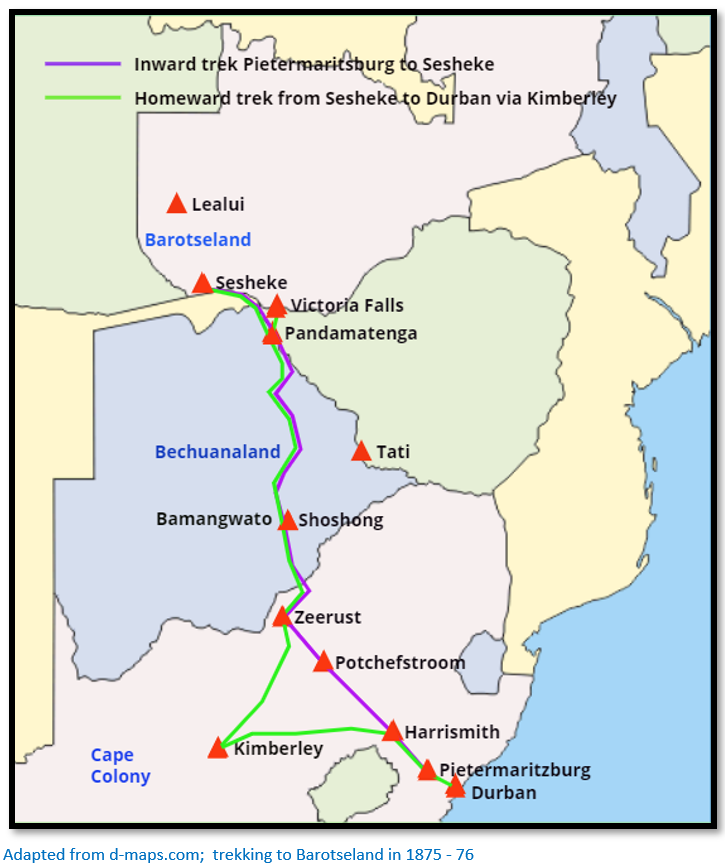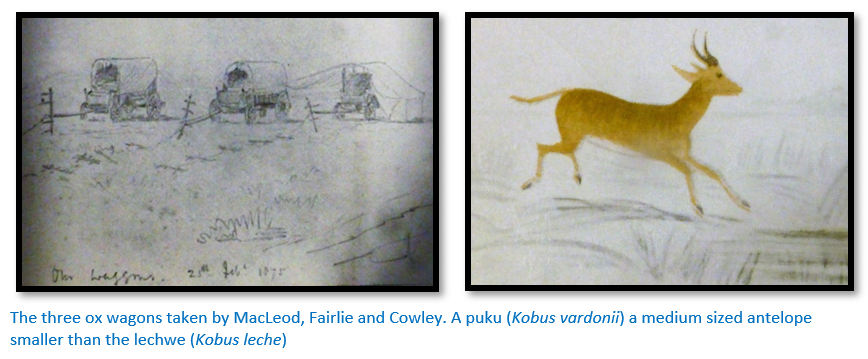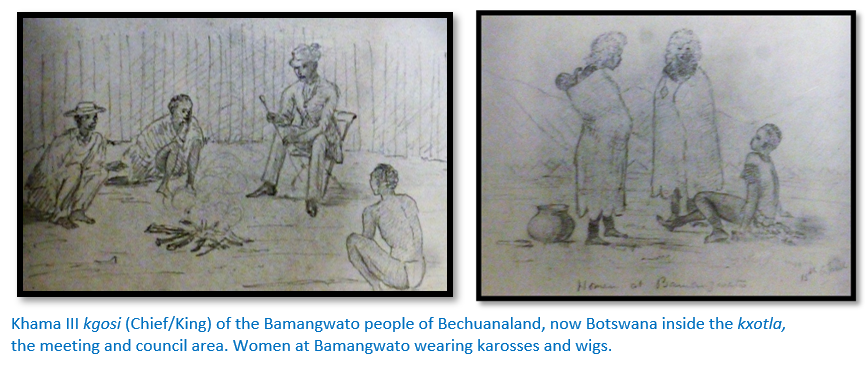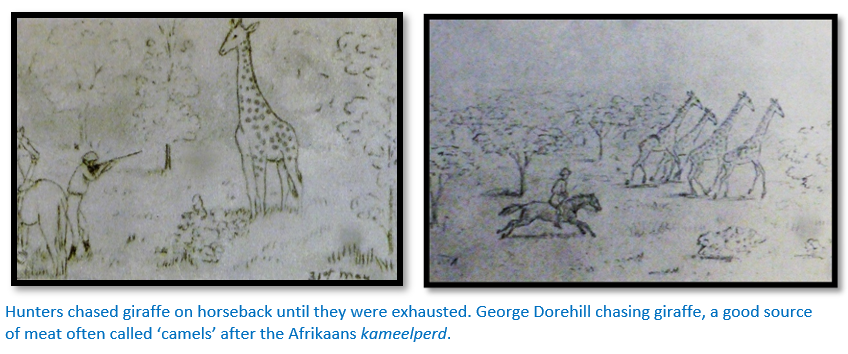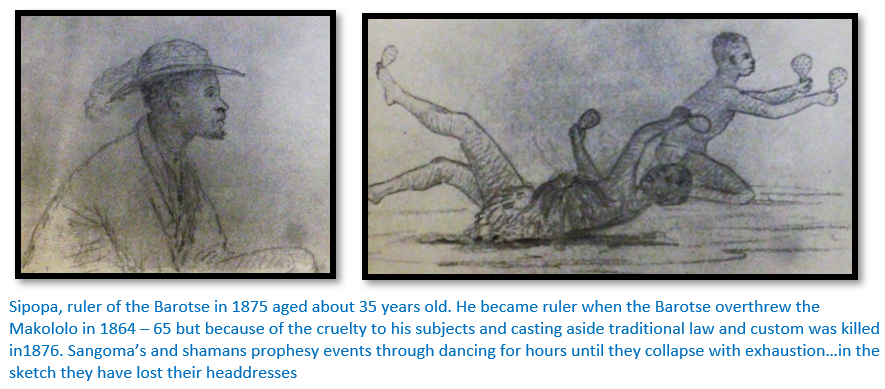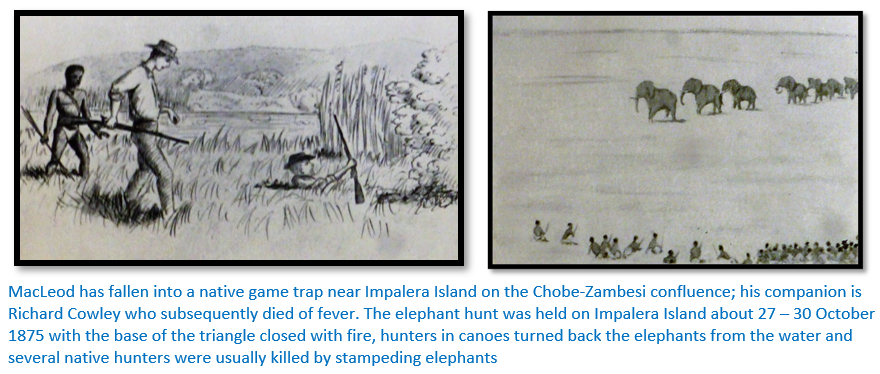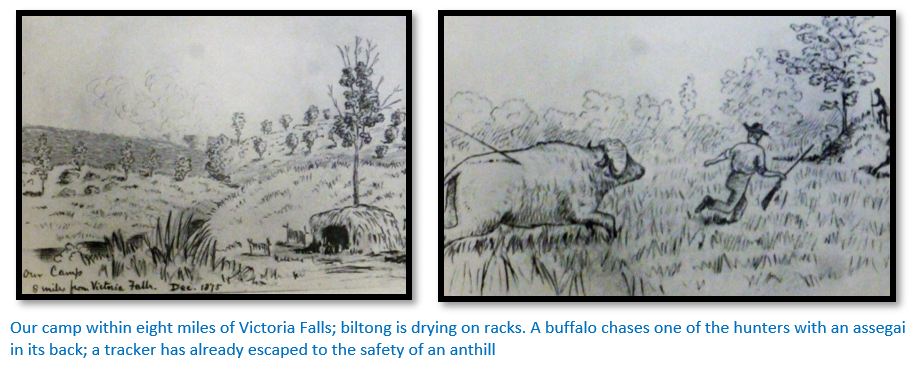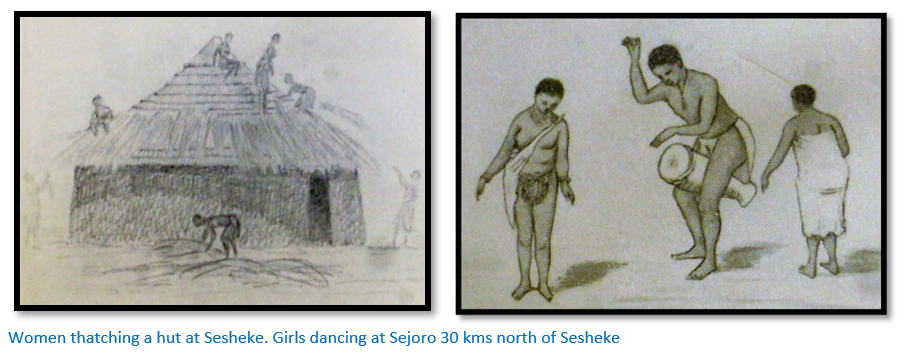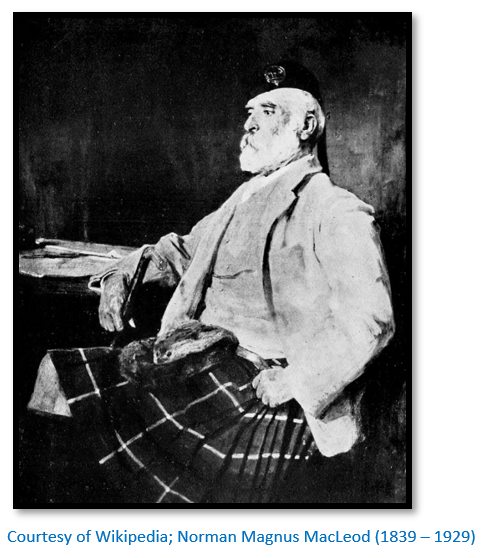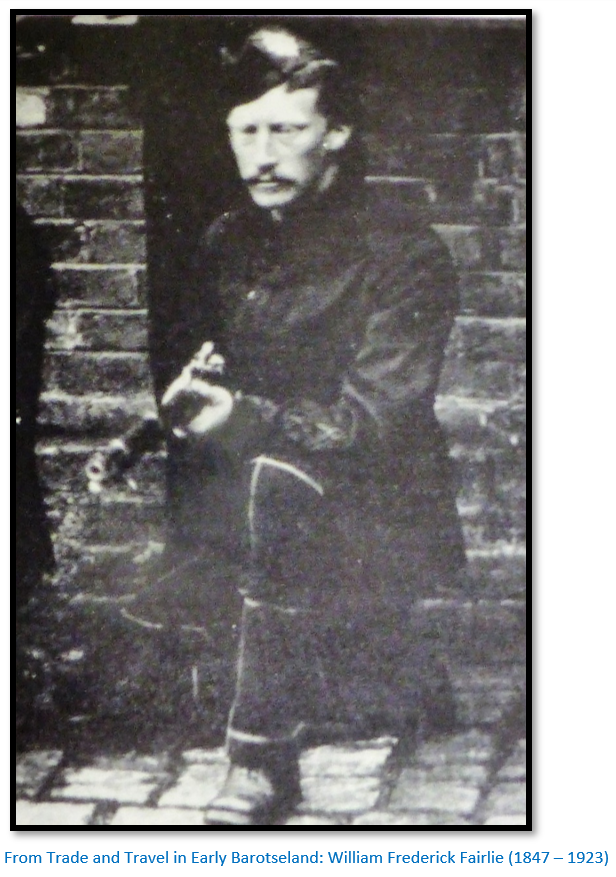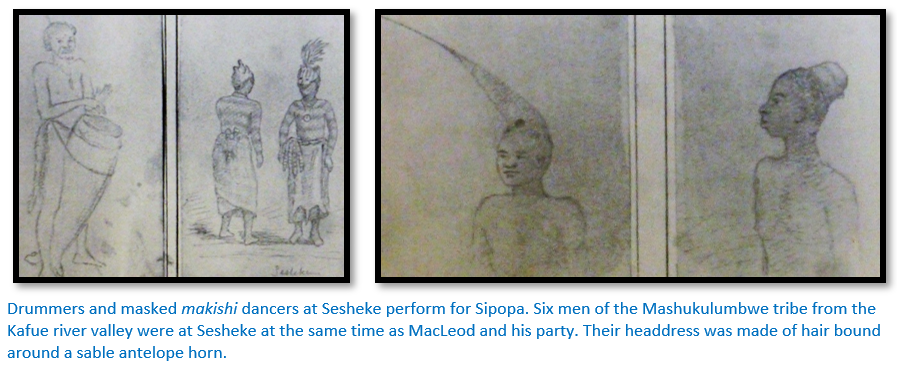Home >
Matabeleland North >
The adventures and hardships of a shooting trip to Barotseland and the Victoria Falls in 1875 – 76
The adventures and hardships of a shooting trip to Barotseland and the Victoria Falls in 1875 – 76
The following account is from the diary[i] of Norman MacLeod (entries are in Italics) and the sketches are by his companion William Fairlie with the artist’s captions. Both were well-to-do friends who had been fellow officers in the 74th Highlanders and their journey to do some big game shooting and see the Victoria Falls was out of the question for ordinary tourists, but not exceptional for young men with the funds and the time to outfit an eighteen month expedition into the Far Interior.
January – May 1875; Pietermaritzburg to Bamangwato (Shoshong)
On 19 January Norman MacLeod with his friend William Frederick Fairlie and Richard Cowley set out from Pietermaritzburg on a hunting trip to the Zambesi. Prior to leaving they:
Engaged four boys, Zulus, for trip to Zambesi at 3/- a month, two as foreloupers[ii] one cook, one groom…Bought pointer ‘Clem’ for £3-10/-…Bought pointer ‘King’ £3. Got another ‘Dinah’ from Woodroffe…Bought twelve oxen from Hawkins, £10 each. Zulu, all inoculated.[iii]
It was not an auspicious start:
We had a wagon and span apiece, supplies for a year, five or six dogs. I had two horses, the others one each. My wagon stuck on the town hill. The oxen did not know their places and the boy couldn’t drive. Then I broke the disselboom.[iv]
They travelled to Harrismith, Potchefstroom, Zeerust and then to Bamangwato (Shoshong)
26 February – To top of Drakensburg (by Van Reenen’s Pass) a long range quite inaccessible except at one or two places and very steep there.
1 March – Harrismith, a good-sized place with plenty of stores. Cold in winter, being so near the berg. Snow lies on the ground. Horses can be bought cheap. Engaged a Totty,[v] Andries, as driver for £3 a month.
4 March – …we lost our best pointer ‘King.’
7 March -…We now travelled steadily on to Potchefstroom, crossing the Vaal river by punt, trekking twice a day at daylight and in the afternoon, using cow dung for fires. We saw springbok and blesbok every day, but only once in great numbers. There it was what Gordon Cumming[vi] has described, thousands and thousands and wildebeest also, a wonderful sight. It was bad luck for me as in galloping after them my horse put his foot in a hole and rolled over. I got a really bad fall, broke my collar bone and damaged my right side and arm so that I couldn’t move it for 3 weeks. We only got one blesbok and one springbok, but plenty of coran.[vii]
27 March – Zeerust, having trekked over same sort of ground since Potchefstroom, open, lots of coran and occasional springbok…Zeerust is a trading station, a rising place, two churches, two or three stores, at the head of the Marico.[viii] Supplies traders and Boer farmers…Passed junction of Marico and Crocodile[ix] Saw quagga, waterbuck, springbok and wildebeest. Country sandy with low thorns. Crossed Notwani river, an apology for a river, nearly dry now with fine trees on banks. Saw koodoo and quagga, I got a shot at a lion the first day I carried a gun, 26 days after my fall, but missed. If I had the proper use of my arm, I don’t think I could have missed.
14 April – Arrived at Bamangwato[x] exactly two months from Howick, about 660 miles. I lost my best horse ‘Guts’ from inflammation of lungs yesterday. Saw our first giraffe yesterday also. Bamangwato is a trading station with several stores. Most of the Zambesi traders load up and start from here…Population said to be 10,000. Kama[xi] the present King is about 45 and seems a nice, intelligent fellow. He is a Christian and dresses as if to walk in Rotten Row. He is now stopping Boers coming in to hunt as they kill off everything for skins and he will not allow liquor to be taken in. The trade is feathers and ivory.
George Dorehill joins their party at Bamangwato (Shoshong)
16 April – Left Bamangwato for the Zambesi in company with George Dorehill, a young fellow who has been trading and hunting for three or four years. I will not continue daily records, but just state generally that we travelled by the western and more direct road by the Kari Kari[xii] leaving the road for a bit and following the Nata river from the drift to Matlamanyane[xiii] into road again. A great deal was heavy sand and slow travelling, also long distances without water (once three days) and water generally only muddy pools.
Fairlie and Cowley each lost a horse close to Bamangwato, after which we had no sickness among horses or oxen. We hunted every day and had fair sport, chiefly giraffe, but also buffalo, eland, quagga, koodoo, sable antelope, wildebeest, springbok and elephant on the Nata river and a rhinoceros.
June to August 1875: Bamangwato to Shesheke (Barotseland)
13 June – we arrived at Pandamatinka [Pandamatenga] where the Zambesi traders leave their wagons while trading across the river. Pandamatenga is about 400 miles from Bamangwato and about 60 miles from the Zambesi at Impareira [Impalera island] where the Chobe joins and where the crossing is.[xiv] Wagons come within 12 miles of the river crossing through two narrow belts of tsetse-fly in the night,[xv] but go back to remain at Pandamatenga where we left ours for seven months.
We waited on the Zambesi five weeks for permission from Sepopa [Sipopa] King of the Barotse people, to visit him at Sesheke his capital on the north bank and sixty miles upriver. After the dearth of water it was a great pleasure to be camped on the river, to bathe every day and have good water to drink. We shot a few buffalo and there were elephants about, but we could not follow them as we expected messengers from the King every day.
At last we got to Sesheke in canoe. Our idea was to get shooting on the north side where game is abundant, as no one can cross the river without the King’s permission and no white men hunt there, but the King’s idea was to get all out of us [as much] as he could and give us nothing in return. After some time he sent us upriver to shoot sea cow. We saw several but could not get one.
Then another delay and he sent us about 40 miles inland north for elephants, but he took care not to send us to a good place. We saw one troop. I shot one, an enormous one, tusks about 100 lbs [45 kgs] each, 7 feet 5 inches long [2.26 metres] but the King did not give them to me. We saw great quantities of other game of all sorts. Cowley[xvi] shot two lions but the game on the Zambesi flats on this bank of the river was a marvellous sight, leche[xvii] and pookoo buck,[xviii] wildebeest and quagga, also buffalo.
Hearing wonderful stories of the annual elephant hunt which takes place at the beginning of the rains when the river is lowest, when they kill we were told, 300 elephants in one day on the flat between the angle of the Zambesi and the Chobe we determined to see it, so we arranged to go back to the wagons, come back to Sesheke and from there go down river to Victoria Falls before the hunt.
So on 16 August started back to the wagons and on 5 September got back to Sesheke again.[xix] I lost a great deal of game on the Zambesi by smashing my favourite rifle and having to shoot with another which I found after several unaccountable misses was sighted all on one side.
September to October 1875: Shesheke
As soon as I got Sesheke I had a slight attack of fever and ague, followed by a severe attack of dropsy[xx] in the legs which kept me literally on my back for twenty-one days and stopped our going to the Falls. I was there some time before I could walk but was just able to join in the elephant hunt[xxi] which was arranged for 29 October and which duly came off but was a failure. However it was worth seeing. There were over 200 canoes on the river at once and about 2,000 men. The system of hunting is by fire, beaters drive the elephants up to the King and party, about 200 who receive them with a volley and then everyone attacks with guns and assegais. But they let the mass of the elephants break back. We only saw fourteen and killed nine, but the fourteen were all bulls with good ivory and it was fine to see them come on. They were turned on all sides and finally charged in a clump down on our party of 200 men. When within 100 yards they received a volley, but if Sipopa had let them come to 30 yards they ought all to have been dropped.
…We then returned to Sesheke and as soon as possible got boats to Impareira and back to wagons. The King did not treat us well going away having got all he could out of us. He would not give me the big tusks I shot, which he had promised to give, and I had given him a valuable horse, beads, two rifles, etc.
November 1875 to March 1876: Pandamatenga to Victoria Falls and return to Kimberley via Bamangwato (Shoshong)
Unfortunately, MacLeod left no impressions of the Victoria Falls. On the first attempt they were within 8 miles but were beaten back by fever and sickness and Richard Cowley subsequently died at Pandamatenga. Of the second attempt he writes: “we got there but were attacked with fever and ague and had a fearful time of it only just succeeding in getting back to wagons alive.”
24 Nov – Got back to wagons. Soon after started with Fairlie for Victoria Falls, got fever on road, nearly died in the bush. Charlie, our best boy, did die. Then Fairlie got it and finally got back to wagons having been for weeks within eight miles of the Falls, without ever seeing them. We found everyone at Pandamatinka had also had fever and poor Cowley was dead. He died on 19 December.
After a weary time of semi-starvation and slow attempts at recovery, I started again for the Falls with Dorehill leaving Fairlie who was not well enough. We hired donkeys from Wisbeach [Westbeech] and rode. We got there but were attacked with fever and ague and had a fearful time of it only just succeeding in getting back to wagons alive. After some further time as soon as we could muster a strong enough party to inspan we started south again on 20 February 1876.
Travelled same road back to Bamangwato. Found water very scarce and very hard up for food. Had to keep the boys on very short rations. Had fever and ague on and off the whole way down and were all weak and ill. I got tossed on horseback by an old buffalo bull. I got off, but horse was killed and not the buffalo.[xxii]
Trekked into Bamangwato on the 1 March where we stayed ‘till 7 March getting my wagon [tyres] shortened, the tires being about an inch off the wood all round.[xxiii] Trekked steadily on by Crocodile river and Marico to Zeerust on 22 March. Crossed Vaal river on 5 April at Christiana and outspanned outside Kimberley Diamond Fields on 11 March.
April to July 1876: Kimberley to England
Large, busy place, all canvas and corrugated iron. Colesburg kopje one big hole 1,000 yards round, two to three hundred feet deep. Remained four days here, then by Boshoff, Winburg to Harrismith on 6 May. Stopped one day and on arriving at Maritzburg on the 16 May having been away exactly fifteen months and ten days. Only stayed long enough to sell wagons. Got 8/6 a lb for ivory.
30 June – Embarked on Florence…Touched at Madeira and arrived at Plymouth on 30 July 1876.
Notes on the participants of the hunting trip
Norman Magnus MacLeod (1839 – 1929)
Norman Magnus was born on 27th July 1839, the son of Norman MacLeod of Dunvegan Castle, Isle of Skye and was educated at Harrow. He decided on an army career and was commissioned ensign in the 74th Highlanders in 1858 joining his Regiment in India. He served as aide-de-camp to General Sir Hope Grant, Commander in Chief in the Presidency of Madras from 1862 to 1865. Retiring from the Army as Captain in 1872, he went to Natal where he held various political appointments and attended Cetshwayo’s coronation with William and Reginald Fairlie. John Dunn gave them permission and help to make a shooting trip with an old hunter named Lewis Reynold between the Black and White Umfolozi rivers. From Pietermaritzburg he transported ammunition to the forces fighting Langalibalele before being appointed as Special Agent for Coolie Immigration at £60 a month and expenses. In 1874 he travelled to India in connection with this task and then served for three months as Protector of Immigrants.
In 1875 – 6 with his friend Fairlie and Cowley he made a big game hunting trip into the interior of Africa described above in the body of the article visiting the Victoria Falls and collecting the trophies which later adorned the Hall at Dunvegan Castle, Skye. On the outbreak of the Zulu War in 1878, he was appointed Political Agent on the Transvaal border and, in the following year, accepted the command of the Zulu Army numbering 8,000 men. The force marched via Lydenburg to Sekhukhune’s mountain and on 28 November 1879 stormed the pass and cleared the caves with much hard fighting before engaging in further fighting and returning home by mid-December. Macleod was awarded the Zulu War Medal and a Companion Order of St Michael and St George (C.M.G.)
MacLeod returned home in 1880. In 1881 he married and became the 26th Chief of the Clan Macleod of MacLeod and the owner of 82,000 acres. He served in numerous official capacities in Scotland and died on 5th November 1929 and was succeeded by his brother.
William Frederick Fairlie (1847 – 1923)
MacLeod and Fairlie were officers together and great friends. His father was a Captain in the 2nd Life Guards and later Lieutenant-Colonel commanding the Ayrshire Yeomanry Cavalry. Fairlie was born on 5 January 1847 and after joining the 9th Highlanders as an ensign transferred into the 74th Highlanders as a Lieutenant to join his great friend Macleod whose families were also connected by marriage and they travelled and served together for many years. He retired from the army in 1873 shortly after MacLeod to go adventuring in Africa as both became tired of garrison life.
He went shooting in 1874 in the Eastern Transvaal and Swaziland from Lydenburg with his brother Reginald. In 1875-6 he and MacLeod and Cowley left on their long journey to the Zambesi and Barotseland. In 1877 he visited Ceylon where his family owned tea estates. In 1879 he was in charge of a Swazi Police Force of about one hundred men which patrolled the Zulu border until its disbandment when he joined George Wood and fought at Ulundi.
He failed to get an Inspectorship in the Natal Police so went elephant hunting in 1880 to the west of the upper Shire River before undertaking an elephant shooting expedition at the north end of lake Nyasa, now Malawi with MacLeod and Lieutenant Henry Faulkner.
Fairlie married in 1885 and joined the Natal Police. During the Second Boer War he commanded the Zululand Native Police with eight European officers[xxiv] and 800 men and served again during the 1906 Zululand Rebellion.
He retired in Scotland and died on 12 October 1923. A good soldier and leader, quiet and unassuming, he was a capable if untutored artist as his sketches show. He made numerous sketches in pen and ink, some coloured with watercolour of the 1875 – 76 Zambesi trip, only a few of the clearer ones are featured in this article.
Richard Cowley
A young Englishman learning farming in Natal who accompanied Macleod and Fairlie to the Zambesi but died of fever at Pandamatenga on 19 December 1875. Dr Holub calls him Frank.
George Dorehill
The son of Major-General William Dorehill he met F.C. Selous on board ship when he came to South Africa in 1871. Journeyed from Kimberley in 1872 with Selous and T.V. Sadlier to Matabeleland. Employed by the trader Kirsch he sold goods in Mashonaland and returned with Frank Mandy to Kimberley. In 1874 he was held up at Makobi’s kraal on the Ingwesi river after Lobengula imposed a quarantine against redwater, a tick-borne disease fatal to cattle. Here he met Frank Oates who rode with him to meet Lobengula on 5 July and was given permission to bring his wagon into Matabeleland and accompanied the Thompson’s to Hope Fountain.
Dorehill met Schinderhutte, one of Westbeech’s employees in October and trekked with him and Oates via the Westbeech Road meeting Selous and George Wood at the Maitengwe river drift. They persuaded Dorehill not to go to the Zambesi in the fever season and he returned with them to Tati on 11 December 1874.
He was at Bulawayo in February 1875 and accompanied Palmer out of Matabeleland in March. He met MacLeod, Fairlie and Cowley at Shoshong and went with them to Barotseland and the Victoria Falls. After Cowley’s death from fever they were back in Shoshong on 1 March 1876 where he parted from Macleod and Fairlie and joined Selous at Sechele’s Town.
By early August Selous and Dorehill were at Tati and after visiting Gubulawayo in December, Dorehill, William Grandy and Lewis Horner accompanied Westbeech to the Zambesi. Dorehill, Grandy and Horner all went down with fever during the rainy season of 1876-77 and Grandy died of its effects after leaving Pandamatenga in the Bakalanga towns north of the Shashe river, as did Frank Oates.
Dorehill spent most of 1877 at the Zambesi and hunted with Selous at Deka in September – October and left on the Westbeech Road with Kingsley and Miller to Tati in December and settled in the Transvaal.
He was in Kimberley in February 1882 and joined Selous from the Limpopo to Shoshong before separating at Tati. In May he was at Gubulawayo but caught dysentery and followed Selous to his camp near the Hunyani, now Manyame river. He hunted the area before starting back to Matabeleland on 6 September 1882 and reached Inyati now Inyathi with Selous in November where they left for Klerksdorp.
References
E.C. Tabler (Ed) Trade and Travel in Early Barotseland. Chatto and Windus, London 1963
E.C. Tabler. Pioneers of Rhodesia. C. Struik (Pty) Ltd, Cape Town 1966
Notes
[i] Macleod mentions each days notes being in an 1875 Letts diary but this has been lost
[ii] Voorloopers
[iii] Zulu oxen were small but sturdy and all inoculated against lung sickness or contagious bovine pleuropneumonia (CBPP) by soaking the yellow virus from the lungs of a contaminated ox into a piece of string which is then threaded through an ox’s tail, tied in a loop and left. This inoculates the ox which develops antibodies
[iv] The main haulage pole of a wagon
[v] Historic term for Hottentot - Khoikhoi, the non-Bantu indigenous nomadic pastoralists of South Africa.
[vi] R. Gordon Cummings wrote in the 1840’s Five Years of a Hunter’s Life in the Far Interior of South Africa
[vii] Probably northern black korhaan (Afrotis afraoides), also known as the white-quilled bustard
[viii] Klein Marico river
[ix] Limpopo river
[x] Shoshong
[xi] Khama III (1837? – 1923), kgosi (chief/King) of the Bamangwato people of Bechuanaland (now Botswana)
[xii] Shoshong past the eastern side of the Makarikari salt pan and joining the Westbeech Road at Nwasha Pan.
[xiii] One of the waterholes of which Nwasha Pan was the last
[xiv] The official entry point for Barotseland
[xv] Tsetse-fly transmits nagana which kills domestic stock but is inactive in darkness
[xvi] Cowley was anxious to make his name as a lion hunter although when he asked Sipopa the King told him he seemed too young for lions.
[xvii] Lechwe antelope (Kobus leche)
[xviii] Puku antelope (Kobus vardonii)
[xix] They met Holub returning to Pandamatenga at Lesuma Vlei between Pandamatenga and Impalera Island on 1 September. MacLeod sent back two horses with Holub but a lion killed one at night
[xx] The old name for oedema
[xxi] Sipopa was initially reluctant for MacLeod, Fairlie, Cowley and Dorehill to attend, but finally sent a canoe to take them
[xxii] Millais in Life of F.C. Selous describes how on the Nata river MacLeod’s horse was hit from behind by the buffalo and both thrown down. MacLeod lay helpless in a thorn bush whilst the buffalo gored his horse to death and then left.
[xxiii] The wagon wheels were bound with flat iron tires and the wood often shrunk in the dry air leaving the tires loose. One temporary solution was to leave the wagon in a stream overnight so the wood swelled and tightened up against the tires.
[xxiv] Arthur Neuman who became famous as an elephant hunter in East Africa (Elephant Hunting in East Equatorial Africa) served as an officer in the force and was also MacLeod’s interpreter and they developed a life-long friendship
When to visit:
n/a
Fee:
n/a
Category:
Province:

